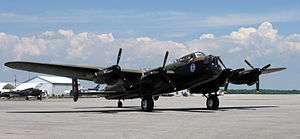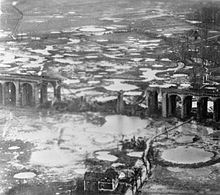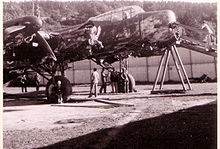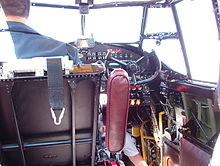Avro Lancaster
| Avro Lancaster | |
|---|---|
 Avro Lancaster Mk.X FM213 |
|
| Type: | Heavy bomber |
| Design country: | |
| Manufacturer: | |
| First flight: |
January 9, 1941 |
| Commissioning: |
1942 |
| Production time: |
1941 to 1946 |
| Number of pieces: |
7377 |
The Avro 683 "Lancaster" was a four-engine bomber from the Second World War from British production. It was the most famous bomber in the Royal Air Force and was used by the RAF Bomber Command from March 1942 .
Developed by the manufacturer AV Roe and Company (AVRO), 7,377 machines in various versions were produced from 1941 to 1946. Thus the Avro Lancaster reached the highest production number of all four-engine British types before the Handley Page Halifax (6,176 machines) and the Short Stirling (2,380 machines).
history
The Avro 683 was developed from the - originally twin-engine - Avro 679 "Manchester" . The Manchester Mk III with the serial number BT 308 , built as a further development of this bomber, had an enlarged wing center section and now four Rolls-Royce Merlin X engines with an output of 1145 hp (854 kW) each. Immediately after its maiden flight on January 9, 1941, it was given the nickname “Lancaster” and was actually the first prototype of the 683 series. Instead of the three-part rudder of the unsuccessful Manchester Mark I, the second prototype, now called the Lancaster DG 595, was modified with the vertical stabilizer with two end plates of the Manchester Mk IA .

In total, Avro manufactured 3425 Lancaster B I, which was a metal construction and could carry a maximum of 6.35 tons of bombs. 33 of the machines were converted to the Lancaster "Special" with an enlarged bomb bay for the heaviest bomb of the war, the 22,000 lb (9,979 kg) " Grand Slam " by the designer Valais . The Lancaster B Mk.III was similar to the B I, but had Packard-Merlin engines built in the USA with a Rolls-Royce license . 3,039 units of the B III were built, 23 machines had suspensions for roll bombs for the " Operation Chastise " (destruction of the Möhne and Edertalsperre ) . 430 similar B Mk.X were made in Canada . There were also 300 units of the B II version with radial engines of the Bristol Hercules VI or XVI type and 180 Lancaster B VII, with a Browning M2 twin MG of caliber .50 BMG (12.7 mm) in a Martin gun stand on the top of the fuselage ) had. In 1942, the Avro York passenger and transport aircraft, developed using the wings and tail unit of the Lancaster bomber, flew for the first time .
The usual defensive armament consisted of eight machine guns of the caliber .303 British (7.7 mm), which were installed in weapon stands with twin machine guns in the bow and on the top of the fuselage and with quadruple machine guns at the stern.
The Avro Lincoln was developed from the Avro Lancaster , the last piston engine-powered type of the RAF Bomber Command.
commitment

The first Avro Lancaster entered service with RAF Squadron 44 in late December 1941. The first deployment was on March 2, 1942, the first bombing took place a week later in an air raid on Essen , followed by the attack on the MAN plant in Augsburg on April 17, 1942 . Lancasters were mainly used in night raids on German cities. They also flew some special attacks, e.g. B. on Möhne and Edertalsperre , on the railway viaducts of Schildesche and Arnsberg with " Grand Slam " bombs, brought the German battleship Tirpitz with 12,000 lb (5443 kg) heavy " Tallboy " bombs to capsize and bombed Hitler's Berghof near Berchtesgaden on 25 April 1945. Overall, Lancaster planes flew over 156,000 sorties in World War II and dropped 608,612 long tons (= 618,000 t) of bombs. More than 3,200 Lancasters were lost in action.
The Lancaster was delivered until the beginning of February 1946; eight years later the last aircraft of this type retired from active service with the RAF. A total of 17 Avro Lancasters are still preserved today, two of which are still airworthy. One is part of the Royal Air Force's Battle of Britain Memorial Flight , the second belongs to the Canadian Warplane Heritage Museum in Hamilton, Canada.
Production numbers
The Lancaster was built in the UK at AV Roe, Metro-Vickers, Vickers in Castle Bromwich and Chester, Armstrong Whitworth and Austin. In Canada the construction took place at Victory Aircraft.
| version | AV Roe | Metro Vickers | Vickers / Castle Bromwich | Armstrong Whitworth | Austin | Vickers / Chester | Victory | total |
|---|---|---|---|---|---|---|---|---|
| Mk I | 896 | 932 | 294 | 880 | 150 | 219 | 3,371 | |
| Mk II | 300 | 300 | ||||||
| Mk III | 2,745 | 136 | 110 | 2,991 | ||||
| Mk VII | 86 | 86 | ||||||
| Mk X | 430 | 430 | ||||||
| total | 3,641 | 1,068 | 294 | 1,290 | 236 | 219 | 430 | 7.178 |
At the end of the war, the Mk VII was still in production.
| year | number |
|---|---|
| 1941 | 18th |
| 1942 | 693 |
| 1943 | 1,848 |
| 1944 | 2,934 |
| until July 31, 1945 | 1,255 |
| total | 6,748 |
Military use
- Fuerza Aérea Argentina : 15 from 1947
- Aéronavale : 45 from Australian holdings from 1952
- 1 machine as Tp 80 for tests
- Soviet Air Force : Two out of six machines that crashed after the attack on the German battleship Tirpitz near Arkhangelsk were repaired; they were briefly used for transport and long-range reconnaissance.
Technical specifications
| Parameters | Avro Lancaster BI data |
|---|---|
| crew | 7th |
| length | 21.18 m |
| height | 5.97 m |
| span | 31.09 m |
| Wing area | 120.80 m² |
| Empty mass | 16,705 kg |
| normal takeoff mass | 30,800 kg |
| Max. Takeoff mass | 31,750 kg |
| drive | four Rolls-Royce Merlin XX; 1,280 PS each (approx. 940 kW) |
| Top speed | 448 km / h at an altitude of 5600 m |
| Marching speed | 338 km / h |
| Climb performance | 6095 m in 41 min with maximum bomb charge |
| Max. Range | 2675 km with 6350 kg bombs |
| Service ceiling | 7467 m |
| Armament | 8 × Browning-MG .303 British (7.7 mm), up to 6350 kg bombs |
Armament
- two Browning machine guns of .303 British caliber (7.7 mm) in a machine-gun turret in the nose
- two machine guns in a rear tower, which secures the air space above and next to the aircraft
- four machine guns in a stern tower securing the airspace behind the aircraft
The aircraft has no downward armament. Therefore, the night fighters of the German Air Force developed a tactic to more easily intercept the Lancaster bombers: They flew their attacks from below. In addition, German night fighters used upward-facing machine guns, called weird music , with which they flew under the bombers and shot upwards.
See also
literature
- Kenneth Munson: Bombers, Patrol and Transport Aircraft 1939–45. 3rd edition, Orell Füssli Verlag, Zurich 1977.
- Olaf Groehler : History of the Air War 1910 to 1980. Military publishing house of the German Democratic Republic, Berlin 1981.
- John Nichol: Lancaster: The Forging of a Very British Legend. Simon & Schuster, London 2020, ISBN 978-1-4711-8046-0 .
Web links
- 20./21. February 1945 - The last flight of the RAF PD421 IQ-F. The archaeological-historical investigation of the crash of a Lancaster bomber at the end of the Second World War in Hagen
- England waged a bombing war with the Avro Lancaster
Individual evidence
- ↑ According to Olaf Groehler and Kenneth Munson, the commissioning took place in December 1941.
- ↑ According to Olaf Groehler: History of the Air War 1910 to 1980. Military Publishing House of the German Democratic Republic, Berlin 1981, p. 397, a total of 7366 copies were built.
- ^ According to Kenneth Munson: Bomber, Patrol and Transport Aircraft 1939–45. 3rd edition, Orell Füssli Verlag, Zurich 1977, p. 153, 3,440 were produced.
- ^ According to Kenneth Munson: Bomber, Patrol and Transport Aircraft 1939–45. 3rd edition, Orell Füssli Verlag, Zurich 1977, p. 153, 3,020 were produced.
- ^ Avro Lincoln. In: www.tangmere-museum.org.uk. September 2013, accessed on April 15, 2020 .
- ↑ The two antennas of a jammer , the so-called Airborne Cigar (ABC), can be seen on the fuselage (cf. Jon Lake: Lancaster Squadrons 1944–45 , In: Osprey Combat Aircraft , Vol. 35. Osprey, Oxford 2002, ISBN 1 -84176-433-7 , pp. 16-17).
- ↑ cf. Kenneth Munson: Bombers, Patrol and Transport Aircraft 1939–45. 3rd edition, Orell Füssli Verlag, Zurich 1977, p. 153.
- ↑ cf. Olaf Groehler: History of the air war 1910 to 1980. Military publishing house of the German Democratic Republic, Berlin 1981, p. 379.
- ↑ a b Public Record Office (National Archives), Kew, stock AVIA 10/311







